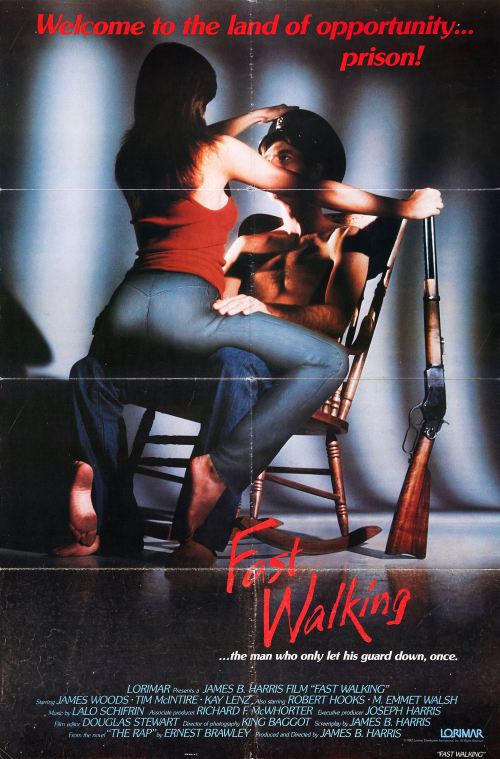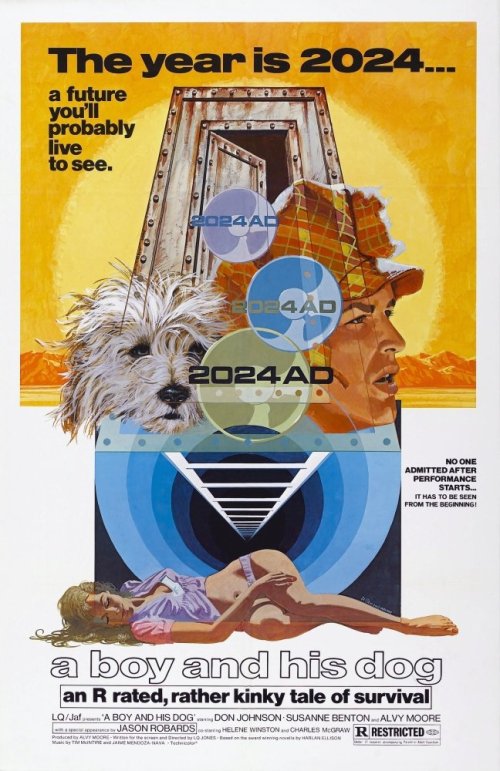
By Richard Winters
My Rating: 7 out of 10
4-Word Review: Guard helps prisoner escape.
Based on the 1974 novel ‘The Rap’ by Ernest Brawley the film centers on prison guard Frank Miniver (James Woods) a pot smoking man who’s unhappy with the low pay of his current job and helps supplement his income by pimping prostitutes to the local Mexican laborers. Wasco (Tim McIntire) is a prisoner at the jailhouse Frank works at who has many outside connections. When a black political prisoner William Galliot (Robert Hooks) arrives at the prison Wasco fashions to have him assassinated by Frank, but Frank has other ideas. He’s already made a deal with Galliot to have him sprung from the inside and in so doing he’ll be given a cool $50,000. Wasco become aware of this other deal, but insists that Frank follow his plan, or he’ll put a hit on Moke (Kay Lenz) an attractive, sharp-shooting lady friend that Frank’s been sleeping with who is also Wasco’s girlfriend. Will Frank choose money over the girl, or will he have a plan-B of his own?
Filmed on-location at the old Montana State Prison building in Deer Lodge, Montana the film has an interesting look to it, which helps accentuate the characters. The American west has always had the allure of escape and individualism, so the rustic landscape here brings out not only Frank’s need to get out of the shackles of his dead-end job, but the prisoners as well. The small town setting has a sort-of renegade vibe where everyone is eager to push-the-envelope of the law and feeling more than confident that they can get away with it. The guards seem almost as corrupt as the men they incarcerate and in some ways even worse. The entertainment is not seeing good conquer evil, but more with which side will manage to out con the other.
The story takes its sweet time getting told with the entire first hour spent just showing Frank’s on the job frustrations before it even gets to the prison break plan. It works more as vignettes than a plot with one amusing moment taking place in the visiting room with one prisoner named Ted (Sydney Lassick) more fascinated with Moke taking off her panties underneath her skirt than with what his own wife (Helen Page Camp) is saying who sits directly in front of him. The cat-and-mouse game that Frank plays with Moke who each challenge the other with their rifle skills with Frank shooting flat the tire of Moke’s motorcycle from a long distance only to have Moke do the same to Frank’s tire on his jeep while he’s driving it is a lot of fun too.
The acting is excellent and the film’s main driver. Lenz looks great, both with her clothes on and off and this marked her career peak as her roles after this were of the supporting variety, or stymied in obscure, low budget flicks. Tim McIntire is also quite good in his second-to-last feature before his untimely death. He spouts a lot of dialogue, which seems almost like a never ending rant at times, but he conveys it in such a snarky, articulate way that it’s still fun to listen to though I was confused why, being a prisoner himself, he was allowed to sleep in the same room as the guards and even socialize with them out in the open. At first I thought he was a guard since he’s given a lot of their responsibilities including lowering the lever each morning that open up the other cell doors. I could only presume that given the corrupt environment and the fact that he was Frank’s cousin that he was given some under-the-table leverage to get these perks and privileges, but it would’ve helped had it been explained better, or given some backstory.
It’s also interesting seeing M. Emmet Walsh here doing yet another nude scene. He has an aging, out-of-shape body type that you’d think no one on this planet would want to see naked, nor would ask to, and yet in a span of 2-years his bare body figured prominently in two different films. In Straight Time he gets his pants pulled down while chained to a fence overlooking a busy highway, which I thought was edgy enough, but here he again gets shown sans his clothes this time from the front side where you get to see underneath his bulging belly his little wee-wee dangling about as he stands outside the front door and yells at Woods who is pulling away, which makes for an image you may want to forget, but might have problems doing.
As for the action there’s not much of it. Sure there’s a couple of shootings, which are quick, and a few fleeting scenes of prisoners falling to their deaths, but that’s about it. No riots, rapes, knife fights, or prison yard fist-fights all stuff that most viewers have come to expect with these types of movies and thus unless they get into the subtle quirkiness may leave disappointed. The inmates are also strangely docile and respectful of authority and even though they greatly outnumber the guards and at times could easily over power them they don’t, which makes it seem not as gritty as it could’ve been though others may not mind this and instead enjoy the film’s offbeat quality including Lalo Schifrin’s bouncy score.
My Rating: 7 out of 10
Released: October 8, 1982
Runtime: 1 Hour 55 Minutes
Rated R
Director: James B. Harris
Studio: Lorimar Productions
Available: DVD-R (Warner Archive), Amazon Video







